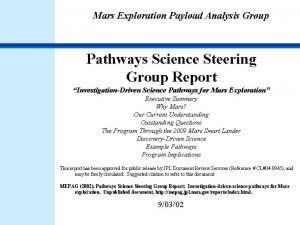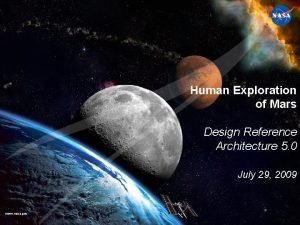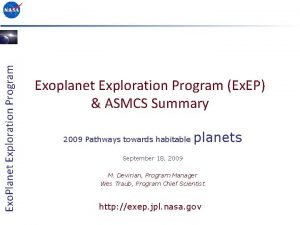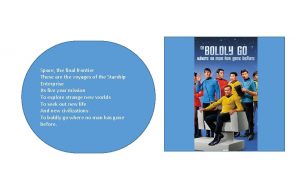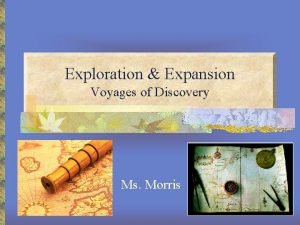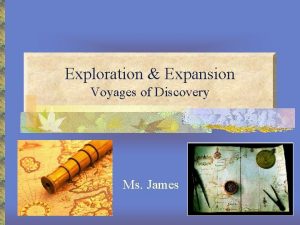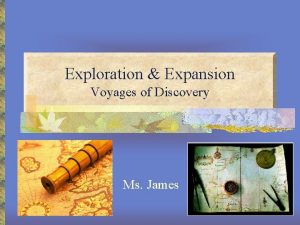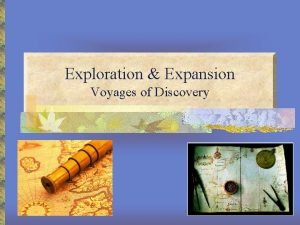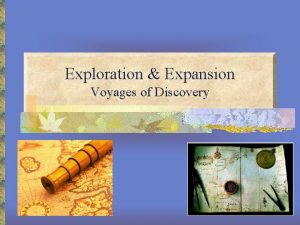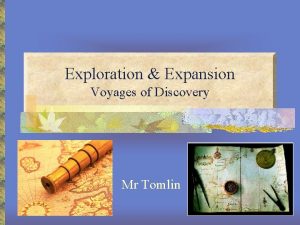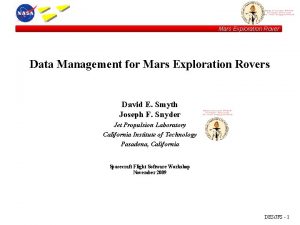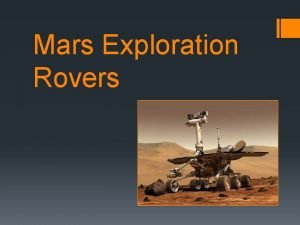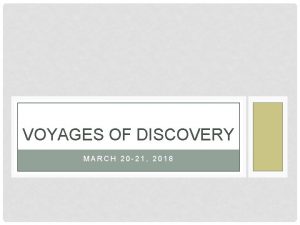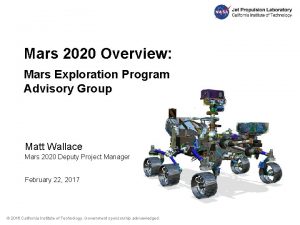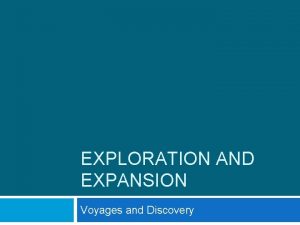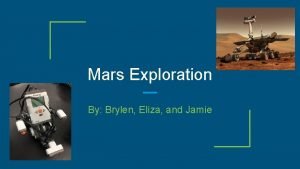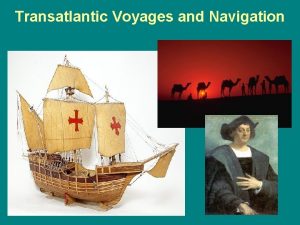Mars Exploration Program Response to Vision and Voyages
















- Slides: 16

Mars Exploration Program Response to: Vision and Voyages for Planetary Science in the Decade 2013 -2022 Michael Meyer MEPAG June 2011 Lead Scientist, Mars Exploration

What Is A Decadal Survey? • Once every ten years, at the request of NASA and the National Science Foundation, the National Research Council carries out a “decadal survey” for planetary science. • The decadal survey involves very broad participation from the planetary science community. • It is the primary scientific input that NASA and NSF use to design their future programs of planetary science and exploration. (The last decadal survey brought us the New Frontiers program. ) • This decadal survey applies to the decade from 2013 to 2022. 2

Process and Timeline Community White Papers Steering Group 1, DC Jul 6 -8. 2009 Mission Studies and Cost Estimation Inner Planets 1, DC Inner Planets 2, Irvine Inner Planets 3, Boulder Aug 26 -28, 2009 Oct 26 -28, 2009 Mars 1, Tempe Mars 2, Pasadena Mars 3, Boulder Sep 9 -11, 2009 Nov 4 -6, 2009 Apr 14 -16, 2010 Primitive Bodies 1, DC Sep 9 -11, 2009 Steering Group Conference Calls Primitive Bodies 2, Irvine Oct 28 -30, 2009 Steering Group 2, Irvine Nov 16 -18, 2009 Steering Group 3, Irvine Primitive Bodies 3, Knoxville Steering Group 4, DC Steering Group 5, DC Feb 22 -24, 2010 Apr 26 -28, 2010 Jul 13 -15, 2010 Aug 3 -4, 2010 Giant Planets 1, DC Giant Planets 2, Irvine; Giant Planets 3, Boston Aug 24 -26, 2009 Oct 26 -28, 2009 May 46, 2010 Satellites 1, DC Satellites 2, Irvine; Aug 24 -26, 2009 Sep 21 -23, ‘ 09 Satellites 3, Boulder; Apr 12 -14, 2010 3

Summary Vision & Voyages • This is a time of great promise in the exploration of the solar system, but also a time of serious budget constraints. • The recommended program is science-driven, and will enable progress across the breadth of solar system research. • A mixed portfolio of small, medium, and large missions is recommended through the decade. • Effective international collaboration is required for success of the program. • A serious effort has been made to evaluate the technical readiness, risk, and cost of all recommended missions. • The planetary decadal survey has involved broad input from the planetary science community, hard work by the study centers and consultants, and the strong cooperation of NASA, NSF, and professional societies. 4

Key Recommendations • Increase the NASA planetary R&A budget by 5% above the total finally approved FY’ 11 expenditures in the first year, and then by 1. 5% above inflation each successive year. • Continue missions in development, and missions in flight subject to senior review. • Continue the Discovery program at its current funding level, adjusted for inflation, with a cost cap per mission also adjusted for inflation (i. e. , to $500 million FY’ 15). • Assure a regular, predictable, and rapid (≤ 24 -month) cadence of Discovery AOs and selections. • Establish a planetary exploration technology development program, funded at 6 -8% of the total NASA PSD budget. 5

Mission Prioritization • Criteria – – Science return per dollar Programmatic balance Technological readiness Availability of appropriate trajectories • Process – All priorities and recommendations were guided strongly by community inputs. – Prioritization within the subject area of each panel was done by the panel. – Cross-panel prioritization was done by the steering group. – All priorities and recommendations were arrived at by achieving strong consensus. 6

Cost and Technical Evaluations • After studies were completed, highpriority mission candidates were subjected to a detailed Cost and Technical Evaluation (CATE) by Aerospace Corporation. • CATE estimates are based on multiple methodologies, including actual costs of analogous past missions, to avoid the optimism inherent in other cost estimation processes. • The result is some sticker shock! But cost realism was demanded by the Statement of Task. • The scope of each recommended mission cannot be permitted to increase significantly beyond what was assumed during the CATE process. • All costs are in $FY’ 15. 7

Assumed Funding Wedge (Data and projections provided by PSD) 8

Planetary Div. Comparative Funding Profiles Decadal, FY 11, and FY 12 Requests President’s FY 11 Budget + inflation (Decadal planning budget) R&A Disco President’s FY 12 Budget* NF Lunar Assumed Flat Budget Mars *Notional Budget in RY$ Outer Planets 9

Recommendations and Mars Responses Recommendation 1 Recommendation The Decadal Survey recommends that the highest priority for the decade 2013 -2022 is the Mars surface science and sample caching mission that begins a NASA-ESA Mars Sample Return campaign. – The mission concept envisioned two separate rovers—a NASA samplecaching rover and the ESA Exo. Mars rover—landed on a pallet by the “sky crane” entry, descent, and landing (EDL) system derived MSL. – The Decadal Survey recommended that the MAX-C mission fly “only if it can be conducted for a cost to NASA of no more than approximately $2. 5 billion FY 2015. ” – Strong ESA participation in the Mars Sample Return campaign (beginning with MAX-C) is critical; the campaign cannot proceed without it. 10

Response 1 Response The NASA-ESA Joint Mars Exploration Program is currently studying a rescoped 2018 Mars mission concept to achieve the science and technology objectives of both NASA and ESA. – A significant cost reduction can be achieved with a single rover design that deletes the landed pallet and avoids a major redesign of the MSL-derived EDL system, while maintaining the NASA-ESA partnership for the Mars Sample Return campaign – The joint ESA-NASA rover currently under study is baselined to retain the Exo. Mars Pasteur scientific payload and subsurface drill. It is also baselined to accommodate the NASA sample handling and caching system, along with the scientific instruments needed to select an outstanding sample. – Benefits of the joint rover concept: • the analytical capability provided by the Pasteur payload may be utilized in the selection of sample suites for the cache. • By retaining the “mobility touchdown” approach of the MSL EDL system, the joint rover concept enables the Pasteur payload to conduct investigations across a greater range of terrain • Maybe the ability to cache the ESA subsurface drill sample. 11

Recommendation & Response 2 Recommendation The Decadal Survey recommends, “based on its high science value and its relatively low cost to NASA, […] flight of the Mars Trace Gas Orbiter in 2016 as long as this [NASA providing the launch vehicle, ESA providing the orbiter, and a joint science payload] division of responsibilities with ESA is preserved. ” Response The joint NASA /ESA 2016 Mars mission, the Exo. Mars/Trace Gas Orbiter (TGO), has advanced on both sides. – The NASA portion of the 2016 mission is now in Phase-A. – The original division of responsibility between ESA and NASA for the 2016 mission has remained stable since the July 2009 Bi-Lateral meeting between ESA and NASA 12

Recommendation 3 Recommendation NASA should “make significant technology investments in the Mars Sample Return Lander, Mars Sample Return Orbiter” during this decade, and that NASA should “establish an aggressive, focused technology development and validation initiative…during 2013 -2022”, and recommends investing in: – A Mars Ascent Vehicle (MAV); precision entry, descent and landing; and rover mobility for the MSR-Lander – Rendezvous and capture and the Earth entry vehicle (EEV) for the MSR -Orbiter; and – Planetary protection technologies for all elements, including investment in the Sample Receiving Facility. 13

Response 3 Response The Mars Exploration Program is continuing the current early investment in MAV technologies and, beginning in FY 13, initiating a technology wedge to support the timely development of the other technologies required to complete the MSR campaign. – Because the MSR campaign will be conducted as part of the Joint Mars Exploration Program with the European Space Agency, the MSR Joint Engineering Working Group is determining which agency will lead specific technology developments. – The JEWG is also identifying areas in which both agencies need to invest to ensure a viable solution. 14

Recommendation & Response 4 Recommend The Decadal Survey recommends that well before sample return mission, NASA should establish a well-coordinated and integrated program for development of the next generation of laboratory instruments to be used in sample characterization and analysis of returned samples. Response The Mars Program has developed a proposal for an NRC study to include an analysis of technology needed for sample characterization and analysis within a Sample Return Facility. – The committee will consider whether all measurements can be done within the SRF and what investments should be done now to enable that instrumentation – Planetary Sciences has a program for development of laboratory instrumentation and advanced analytical techniques required for the complete analyses of the returned samples (Laboratory Analysis of Returned Samples). 15

Questions?
 Mars exploration program analysis group
Mars exploration program analysis group What is the cycle of conquest
What is the cycle of conquest Mars design reference mission
Mars design reference mission Natural and forced response
Natural and forced response Natural response circuit
Natural response circuit Primary immune response and secondary immune response
Primary immune response and secondary immune response Asvab occu find
Asvab occu find Asvab
Asvab Exoplanet exploration program
Exoplanet exploration program Grand corp malade le train
Grand corp malade le train Which phrase correctly describes the tang dynasty?
Which phrase correctly describes the tang dynasty? Des voyages interessants answers
Des voyages interessants answers Should we celebrate the voyages of zheng he dbq answer key
Should we celebrate the voyages of zheng he dbq answer key Space the final frontier these are the voyages
Space the final frontier these are the voyages Gerard pons voyages
Gerard pons voyages Francisco pizarro voyages map
Francisco pizarro voyages map Thomas cook voyages 9 rue du puits mauger 35000 rennes
Thomas cook voyages 9 rue du puits mauger 35000 rennes
